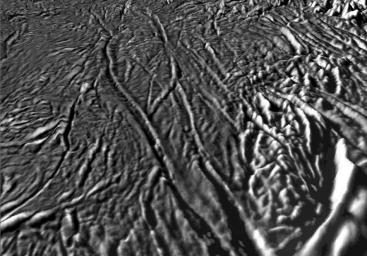
|
Tiger Stripes on Enceladus - Fracture Zones and Plumes Sources
- Click the image above for a larger view
- Full-Res JPEG (887 x 619) (125.1 kB)
- Full-Res TIFF (887 x 619) (549.8 kB)
Caption:
The plumes of water and other ice vapors jetting from the surface of Enceladus are one of the most exciting astronomical discoveries of the 21st century. These plumes originate from long linear fractures near the south pole of Enceladus. New topographic maps give us a fresh unprecedented look at this geologically young and active region. This perspective view shows several of these "tiger stripes" from which the plumes are venting. The stripes themselves consist of deep grooves flanked by two elevated ridges. The south polar terrains generally are also heavily fractured and deformed. These new topographic maps, constructed from stereo and shape-from-shading techniques by Dr. Paul Schenk ( http://www.lpi.usra.edu/lpi/schenk/ ) at the Lunar and Planetary Institute, show that the stripes do not have a lot of relief. The flanking ridges are typically 75 to 200 meters high while the grooves in between the ridges are 150 to 300 meters deep. Intensely deformed ridges along the edge of the south polar terrains (lower right) have relief of up to 1 kilometer or so. Vertical relief has been exaggerated by a factor of 20 in this view to aid interpretation.
Background Info:
The raw data from which this product was developed were retrieved from the Planetary Data System's Cassini archives. The Cassini-Huygens mission is a cooperative project of NASA, the European Space Agency and the Italian Space Agency. The Jet Propulsion Laboratory, a division of the California Institute of Technology in Pasadena, manages the mission for NASA's Science Mission Directorate, Washington, D.C. The Cassini orbiter and its two onboard cameras were designed, developed and assembled at JPL. The imaging operations center is based at the Space Science Institute in Boulder, Colo. ( http://ciclops.org )
Cataloging Keywords:
| Name | Value | Additional Values |
|---|---|---|
| Target | Enceladus | |
| System | Saturn | |
| Target Type | Satellite | |
| Mission | Cassini-Huygens | |
| Instrument Host | Cassini Orbiter | |
| Host Type | Orbiter | |
| Instrument | Imaging Science Subsystem (ISS) | |
| Detector | ||
| Extra Keywords | Grayscale, Plume, Water | |
| Acquisition Date | ||
| Release Date | 2008-03-25 | |
| Date in Caption | ||
| Image Credit | NASA/JPL/Space Science Institute/Universities Space Research Association/Lunar & Planetary Institute | |
| Source | photojournal.jpl.nasa.gov/catalog/PIA10352 | |
| Identifier | PIA10352 | |
